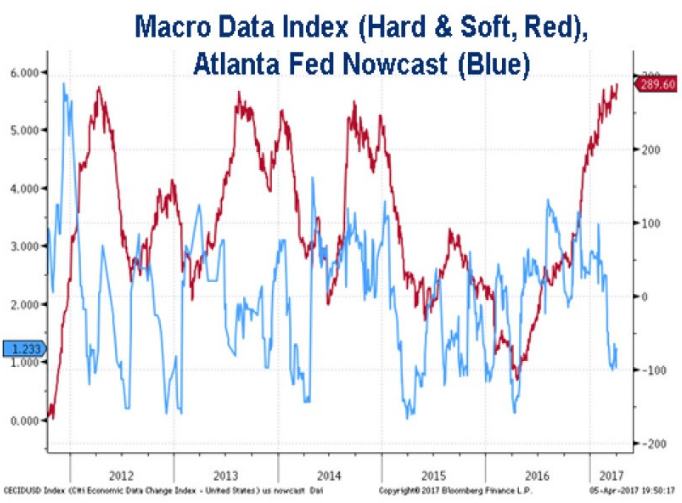For the past 3 months there’s been a raging battle between the Atlanta Fed and the New York Fed. The Atlanta Fed relies mostly on hard data when predicting GDP growth, whereas the New York Fed puts relatively more weight on consumer sentiment. Republicans became much more optimistic after Trump was elected, so the sentiment indicators pointed to much stronger growth than the hard data indicators. The following graph shows the huge divergence that developed in recent weeks:
Image may be NSFW.
Clik here to view. The actual growth was only 0.7%, which was much closer to the bearish Atlanta Fed’s 0.2%, than the New York’s Fed’s bullish 2.8%. This reminds me a bit of the post-Brexit vote growth in the UK.
The actual growth was only 0.7%, which was much closer to the bearish Atlanta Fed’s 0.2%, than the New York’s Fed’s bullish 2.8%. This reminds me a bit of the post-Brexit vote growth in the UK.
I don’t like either hard data or sentiment; I like market forecasts. Unfortunately we lack a NGDP futures market (I’m working on setting one up again, and will have an announcement soon), but we do have some market indicators. The preceding graph and the following quotation were from an April 12 article:
Tying in with the earlier point, the rally in the ten-year bond is consistent with the Atlanta Fed’s forecast for low growth in Q1.
So the bond market seemed to sense that growth was weakening.
Is it too early to attribute any of this to Trump? I’d say so. But the Trumpistas all crowed in early February when the strong January jobs report came in. This was attributed to the magic powers of Trump, despite the fact that he had not even taken office when the January survey was conducted. I don’t know how they’ll reconcile this GDP report with their dreamy predictions of 4% growth as far as the eye can see, but I’m sure they’ll think of something.
There’s likely to be some bounce back in Q2 (poorly measured seasonality depressed Q1), but I’m sticking with my view that America’s new trend RGDP growth rate is 1.2%, or 1.5% if Trump succeeds in getting his supply-side reforms passed.
PS. Core PCE is up 2% over the past year, so the Fed is hitting both its price and employment targets. For the moment, they are fulfilling their dual mandate. That’s a problem for Trump, who needs some Arthur Burns-style recklessness to paper over his personal incompetence when it comes to developing supply-side policy reforms.
Update: I got the core PCE inflation data from the FT. Ant1900 points out the true figure is 1.7%, still below target.
PPS. I have a new post at Econlog explaining job shortages.
